
Tour the Demoiselle
Brazilian aviation pioneer Alberto Santos-Dumont dreamed of
making flight accessible to the general public. In 1907, he
unveiled a design he hoped would meet this goal: a tiny
aircraft he called the Demoiselle, or Damselfly.
Weighing only 300 pounds, its airframe was compact and easy to
build, and served as a viable starting point for budding
aviators. By 1910, Popular Mechanics magazine published
plans for the latest model of the aircraft with high praise,
inspiring a number of early enthusiasts to build their own. In
this audio interactive, explore a replica of a 1909
Demoiselle #20 and discover the unique design features
of the world's first ultralight sport plane.—David Levin
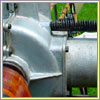

|
|
Detroit Aero Engine
On this example of the Demoiselle #20, this
engine is called a Detroit Aero Engine. And it came out
the same time as this Demoiselle from 1909. In
France they would have used Darracq aircraft engines.
They would have used another example, too, the
Dutheil-Chalmers, I believe is how it was pronounced,
both about the same power, both about the same weight.
But if you were to build a Demoiselle in America,
well, this is the type of engine you would have put on
it—the 1909 Detroit Aero Engine. It had an rpm of
about 1,200 rpm, which is common for most of the engines
of that period. It only weighed 110 pounds. It was
air-cooled and provided power at about 30 or 35
horsepower.
|
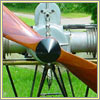

|
|
Propeller
The design of the propeller is pretty traditional to the
aircraft of their day. It had a sort of a graceful "S"
look to it. If you could draw a very shallow S, it had a
very nice curve. They were very slow-turning propellers.
Today we have these little toothpick props that turn up
thousands of rpm. But back then a slow-moving propeller
was much more efficient. And the propeller [was] made of
a variety of woods such as mahogany and birch. A very
efficient propeller. The only drawback with the
Demoiselle was if you notice where the pilot sits
in some of the other photos, you'll see how close the
propeller is to the pilot's feet, which is something you
always are aware of when you're flying one of these
little airplanes.
|


|
|
Wing Structure
One of the things that the early designers were trying
to come up with were ways to make an airframe strong but
make it light. One of the woods they experimented with
was bamboo. Santos-Dumont used it quite liberally in his
designs of his Demoiselles. This example, as you
can see, is all held together with bamboo. You didn't
use glue or screws because the bamboo was very frail
around the areas where it needed to join to another
piece. You'd lash it together. Sometimes I felt like
Robinson Crusoe building this airplane. You can see the
liberal use of brass wire, which was used originally to
clamp all the pieces together. Then the fabric is just
basically laid over the top, stitched in between the
ribs. And then it was laced to the front with that
little baseball stitch style that you see.
|
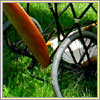

|
|
Main Landing Gear
The landing gear of the Demoiselle was pretty
standard fare for its day. The frame is connected to the
gear directly. Very light, very frail wheels, so you had
to land very gently. They're basically bicycle wheels.
And the advantage of where the pilot sat is where he
could stretch out and use his hands to stop the
airplane. It's always a good thing to be able to do that
if you're landing kind of quickly. And you'll notice
that Santos-Dumont usually wore gloves when he flew the
airplane, for protection when he grabbed the wheels to
slow down.
|
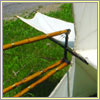

|
|
Tail Assembly
In this picture we're looking at the tail of the
airplane, which is sort of unique, because it operates
as a rudder and as an elevator all in one assembly. It's
built of bamboo, much like the rest of the airplane.
Trailing edge is nothing more than a piece of wire
connected to each of those pieces of bamboo you see
sticking out of the fabric. And this would be used for
your pitch and steering of the Demoiselle.
|
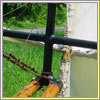

|
|
Cruciform
A closer look at the tail shows what is known as the
cruciform, a design that Santos-Dumont came up with,
which is sort of like a universal joint. The rudder and
the elevator were connected together. And this is a
hinged affair where, when you operated the controls in
the cockpit, you could make the tail either move up and
down along a hinge on the horizontal axis, and along the
vertical axis you could operate it from left to right
for steering. A very simple affair, very efficient, and,
of course, you want to keep it very light and strong.
And this design worked perfectly for this airplane.
|
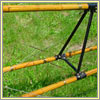

|
|
Bamboo Frame
One of the significant structures of the
Demoiselle is the triangular fuselage made of
three bamboo poles. You can see the use of the bamboo,
and also the concept of incorporating some steel into
the structure to give it some strength, the steel tubes
that form the triangular fuselage. You had a structure
much like a bridge, a very, very strong, lightweight,
resilient structure. And it was very, very successful
for this particular airplane. A little detail note that
you'll notice in between what are known as nodes, the
little bumps on the bamboo poles, you'll see some brass
wire wrapped. This wasn't for decoration. This was used
to keep the bamboo from splitting along its length.
|
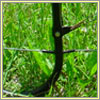

|
|
Tail Skid
Santos-Dumont tried several different designs of the
Demoiselle. Some of them had a tail wheel. Some
had a skid and a tail wheel. This example of the
#20 has just the tail skid, and it resembles a
little bit of an umbrella handle, if you will. Made of
steel tubing just heated up and bent round, and then
braced with some wire to keep it from breaking off of
the airplane. You'll notice that there's a little
structure just before the curve on the bottom. And
that's fastened to the frame so that as the airplane
rolls forward it wouldn't pull the tail skid off.
|
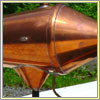

|
|
Fuel Tank
This is a picture of the gas tank for the
Demoiselle. It didn't hold very much fuel, but
you weren't planning on flying very far. They were very
small tanks. The copper line that's coming down from the
front of the tank is the fuel line. That curled look to
it is not just for Jules Verne style or anything. That
is actually very practical and very useful. And that was
used to dissipate the vibration from the engine so that
the fuel line wouldn't crack. And by curling it like
that, you added a lot more life to the fuel line.
|
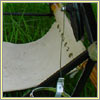

|
|
Pilot's Seat
We're looking at the cockpit, if you will, of the
Demoiselle #20. And here is the canvas seat that
the pilot would sit in. It's simply a piece of canvas
that's laced to the sides of the lower bamboo poles. No
safety belts in this airplane. And you would just make
yourself as comfortable as you could in there. There
were a couple of little stirrups up front for your feet
to rest on. But that was all there was to the seat.
|
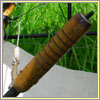

|
|
Elevator Control
One of the four controls of the Demoiselle is the
elevator. This stick that you see in front of the canvas
seat is basically a stick that moves forward and
backwards. And that would operate your pitch control and
operate the cruciform tail, where you would pull back on
the stick, and you would climb; push forward and you
would dive. Very, very simple. There's a little black
button you'll see on the top of the stick. And this was
used to turn the engine on and off. And all you do is
push that button. It was a spring-operated switch, so
it'd briefly interrupt the power to the engine so you
could slow down.
|
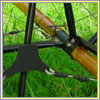

|
|
Rear Control Stick
This little stick that was behind the pilot would aid in
banking the airplane into the direction you wanted to
go. To activate it you had a small pocket sewn into the
back of your leather jacket. And some of the pilots even
used a strap, a leather belt to go around their waist to
not only keep that pocket secure with the stick but also
to aid in moving it. So as you leaned in the seat from
side to side, you could bank the airplane. Lean to the
left, you banked to the left; lean to the right, and you
would bank to the right.
|
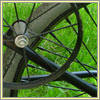

|
|
Rudder Control
The rudder was operated simply by this tiny wheel that
was welded on to the bracing of the interior section, if
you will, of the cockpit. It was a simple little device.
It operated the cruciform tail to steer the airplane.
This would move the tail left and right to make turns.
As you pushed forward, you could make a right turn. As
you pulled back, you could make a left turn.
|
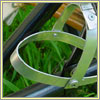

|
|
Throttle Toe Clip
On the Demoiselle there were two ways to operate
the throttle. One was the button that was on top of the
elevator stick, and the other way was with this throttle
toe clip. This clip would connect to your left shoe,
into the toe. And the wire that you see would go up to a
spring-loaded affair which would connect to the
carburetor. And to operate the throttle, it was a little
bit like operating a gas pedal in your car. As you press
forward, you go faster, and as you release, you would go
slower.
|
|

|















